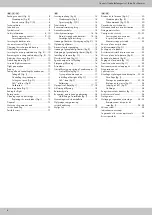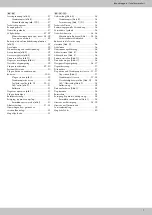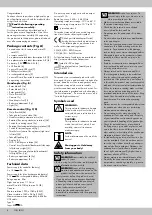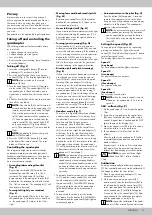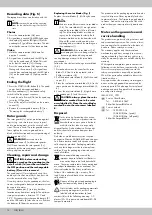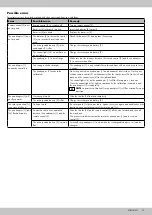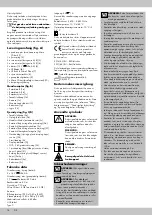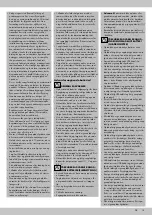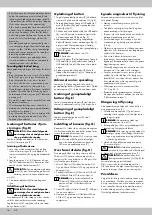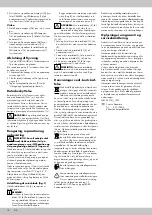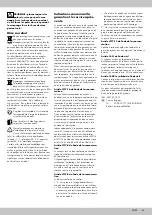
12
GB/IE/NI
Recording data (Fig. S)
Photographs or videos can be taken with the
camera.
NOTE:
remove the protective covering
from the lens before using it for the first
time.
Photos
1. Press the camera button (2b) once.
2. A signal tone is emitted, CAMERA lights up on
the display (2j) and the LED lights (1h) of the
quadcopter (1) go off for a short time. This indi-
cates that the camera (1e) has taken a photo.
Video
1. Hold the camera button (2b) down for
approx. 3 seconds.
2. A signal tone is emitted, and the LED lights
(1h) on the quadcopter (1) blink. This indi-
cates that the camera (1e) is filming.
3. Press the camera button (2b) again to stop
filming with the camera (1e). A signal tone
is emitted as confirmation, and the LED lights
(1h) on the quadcopter (1) light up continu-
ously.
Ending the flight
1. Press the START/LAND button (2i). The quad-
copter slowly descends and lands.
After the quadcopter (1) has landed safely,
switch it off in the proper sequence.
2. Switch the on/off switch (1d) on the quadcop-
ter to the OFF position.
3. Turn off the on/off switch (2a) on the remote
control (2).
4. Remove the rechargeable battery (9) (see
“Removing the rechargeable battery”).
Rotor guards
The rotor guards (1c) act as protection against
injuries (e.g. cuts, skin injuries or eye injuries)
and to protect against, or in the event of, colli-
sions. These are fixed. If a rotor guard becomes
loose, tighten the screws again and dou-
ble-check the function and correct positioning of
the rotor guards (1c).
WARNING:
never operate the
quadcopter (1) without rotor guards
(1c)! Do not remove the rotor guards (1c)
arbitrarily, as this may endanger yourself and/or
other people and animals!
Cleaning, repair and storage
CAUTION:
before undertaking
any work on the quadcopter, the
on/off switch (1d) must be switched to
the OFF position and the rechargeable
battery (9) must be removed.
The quadcopter (1) must always be kept dry,
and any dirt such as wool fibres, hair, dust, etc.,
must be removed after every flight.
Use a dry cloth to dry the quadcopter; the elec-
tronics, rechargeable battery and motor must not
be exposed to water.
Store the quadcopter (1) in a dry, dust-free
location away from direct sunlight. The optimum
storage temperature is between 10°C and
25°C. Disconnect the rechargeable battery (9)
and the USB cable (6) when not in use. Remove
the batteries (5) from the remote control.
Replacing the rotor blades (Fig. I)
Replace the rotor blades (3, 4) if they become
damaged.
NOTE:
there are two different kinds of rotor blades
(3, 4). The rotor blades (3) are right-rotat-
ing and the rotor blades (4) are left-rotat-
ing. The left-rotating blades are shaded
in grey on the diagrams for clarity. Both
kinds are marked on the bottom side with
(A) and (B), which must be noted when
replacing and must match the markings on
the quadcopter (1).
WARNING:
if the rotor blades (3, 4)
are damaged, there is a danger of parts
becoming detached during use and
causing damage or harm to the immediate
environment.
Follow the steps below to change a rotor blade
(3, 4):
1. Detach and remove the screw for the rotor
blade (3, 4) that is to be replaced, with a
Phillips screwdriver (8).
2. Pull the broken rotor blade (3, 4) off the quad-
copter (1).
3. Place the replacement rotor blade (3, 4) in the
same position as the damaged rotor blade (3,
4).
4. Screw the new rotor blade (3, 4) tightly onto
the quadcopter (1) with the screw.
CAUTION:
always place the rotor
blades marked A onto the rotor
arms labelled A. Place the rotor blades
marked B onto the rotor arms labelled
B.
Disposal
In the interest of protecting the environ-
ment, do not throw your product into the
household waste once you are finished
with it, but rather take it to a specialty
disposal facility. Find out about collection sites
and their hours of operation from your local
authority.
Defective or used batteries must be recycled
pursuant to Directive 2006/66/EC and changes
to it. Return batteries and/or the product via the
collecting sites provided. Packaging materials,
such as plastic bags, must be kept away from
children. Keep the packaging materials out of
reach of children.
Environmental damage caused by
improper disposal of batteries! Batteries
may not be disposed of with household
waste. They may contain toxic heavy metals and
are subject to hazardous waste treatment. The
chemical symbols of the heavy metals are as
follows: Cd = cadmium, Hg = mercury, Pb =
lead. Dispose of used batteries at a municipal
collection site.
Dispose of the product and packaging in
an environmentally friendly manner.
Note the label on the packaging materials
when separating waste, as these are
labelled with abbreviations (a) and
numbers (b) with the following meaning: 1–7:
plastics/20–22: paper and cardboard/80–98:
composite materials.
The product and the packaging materials can be
recycled, dispose of them separately for better
treatment of waste. The Triman logo only applies
to France. Find out how to dispose of the used
product from your municipal or city administra-
tion.
Notes on the guarantee and
service handling
The product was produced with great care and
under constant supervision. You receive a three-
year warranty for this product from the date of
purchase. Please retain your receipt.
The warranty applies only to material and
workmanship and does not apply to misuse or
improper handling. Your statutory rights, espe-
cially the warranty rights, are not affected by this
warranty.
With regard to complaints, please contact the
following service hotline or contact us by e-mail.
Our service employees will advise as to the
subsequent procedure as quickly as possible.
We will be personally available to discuss the
situation with you.
Any repairs under the warranty, statutory guar-
antees or through goodwill do not extend the
warranty period. This also applies to replaced
and repaired parts. Repairs after the warranty
are subject to a charge.
IAN: 322151_1901
Service Great Britain
Tel.: 0800 404 7657
E-Mail: [email protected]
Service Ireland
Tel.: 1890 930 034
(0,08 EUR/Min., (peak))
(0,06 EUR/Min., (off peak))
E-Mail: [email protected]




